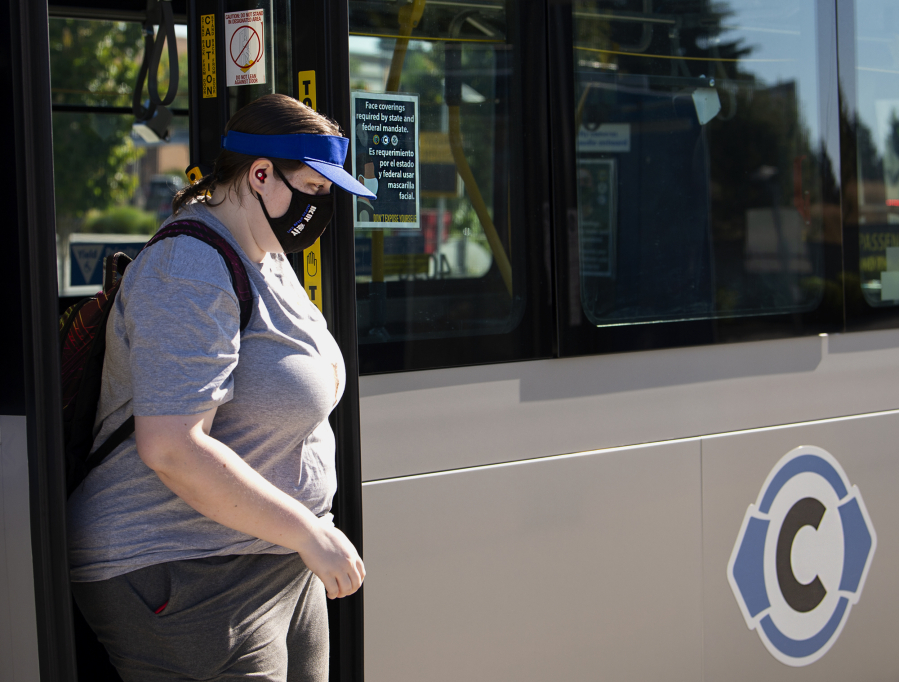June 30 marked the end of most of Washington’s COVID-19 pandemic restrictions including the indoor mask mandate at most businesses and public locations, but the requirement has persisted for transit riders on C-Tran buses due to separate state and federal mandates.
That date did bring an end to occupancy restrictions on C-Tran buses, however. It was a welcome change of pace given that ridership has begun to rebound in recent months. Buses were previously capped at 75 percent occupancy.
“Every day, we’re seeing an uptick,” said Chris Selk, C-Tran director of communication and customer experience.
C-Tran’s ridership plunged during the pandemic, although Selk noted that C-Tran saw the smallest negative impact out of all transit agencies in Washington.
For example, C-Tran saw a drop of 50-60 percent from its usual average on most days in the second half of March and April 2020, while King County Metro saw average declines of 70-80 percent and Sound Transit saw declines of 80-90 percent during the same time period, according to the state’s COVID-19 transportation data dashboard.
C-Tran’s total ridership numbers plummeted when the pandemic first set in, dropping to 388,656 in March 2020 and then 246,391 in April 2020, the lowest-traffic month of the pandemic. For comparison, monthly ridership ranged from 468,994 to 566,707 from January 2018 through February 2020.
Monthly ridership stayed within a range of 249,000 to 284,000 for the next 10 months, averaging about 269,455. Signs of improvement emerged in the spring of this year; March saw 299,656 rides, followed by 292,201 in April. May dropped to 278,433, lower than the two prior months but still higher than all but two of the pandemic months.
The drop in ridership has produced declines in farebox revenue — exacerbated by the fact that C-Tran switched to rear-door boarding and stopped collecting fares on most of its regular routes for several months last year in order to facilitate social distancing — but fare dollars only account for about 15 percent of C-Tran’s revenue under normal circumstances.
The agency has received federal support in the past year to help bridge that gap, including $15 million through the initial pandemic relief CARES Act.
More improvement expected
It’s difficult to predict the timing of a full return to pre-pandemic ridership, Selk said, in part because the pandemic has changed the landscape of the corporate office environment. However, the agency is expecting to see a significant uptick when in-person school resumes in September, due to the large number of students who use C-Tran’s Youth Opportunity pass program.
The reduced ridership has allowed the agency to keep pace with demand despite having to block off much of the seating area in each bus. There have been a couple of close calls, Selk said, including a heavy storm over the Valentine’s Day weekend, but bus drivers have avoided having to turn away waiting riders.
At this point, all bus seats are open and the total occupancy limit per bus is the same as it was pre-pandemic.
The U.S. Centers for Disease Control and Prevention issued a Jan. 29 order requiring all people to wear face masks on public transportation nationwide, including transportation hubs like airports and bus stations.
The CDC announced last month that it would relax the mask mandate for outdoor portions of transportation hubs, although the agency still recommends that unvaccinated individuals wear masks in those areas. Washington’s rule does not make the same exception, so masks are also still required at C-Tran transit centers and boarding platforms for the time being.
“We will be following masking mandates until there are no masking mandates,” Selk said.
C-Tran’s regular routes have generally continued to operate on their usual schedules during the pandemic, but some express routes have been curtailed due to exceptionally steep drops in ridership. Those changes are likely to continue for the time being, Selk said.
The changes include suspension of service on Route 177, temporary reductions on Routes 105, 157 and 164 and a combination (and reduction) of Routes 134 and 199. The Vine’s weekday peak frequency has also been reduced to 12 minutes.




